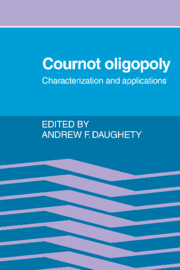Book contents
- Frontmatter
- Contents
- Preface
- Part I Introduction
- Part II Background
- Part III Examining Cournot's model
- Part IV Applications
- 12 Cournot and Walras equilibrium
- 13 Duopoly information equilibrium: Cournot and Bertrand
- 14 Information transmission – Cournot and Bertrand equilibria
- 15 Uncertainty resolution, private information aggregation, and the Cournot competitive limit
- 16 Losses from horizontal merger: the effects of an exogenous change in industry structure on Cournot–Nash equilibrium
- 17 Delegation and the theory of the firm
- 18 A study of cartel stability: the Joint Executive Committee, 1880–1886
12 - Cournot and Walras equilibrium
Published online by Cambridge University Press: 07 September 2009
- Frontmatter
- Contents
- Preface
- Part I Introduction
- Part II Background
- Part III Examining Cournot's model
- Part IV Applications
- 12 Cournot and Walras equilibrium
- 13 Duopoly information equilibrium: Cournot and Bertrand
- 14 Information transmission – Cournot and Bertrand equilibria
- 15 Uncertainty resolution, private information aggregation, and the Cournot competitive limit
- 16 Losses from horizontal merger: the effects of an exogenous change in industry structure on Cournot–Nash equilibrium
- 17 Delegation and the theory of the firm
- 18 A study of cartel stability: the Joint Executive Committee, 1880–1886
Summary
Introduction
This paper unifies the two leading classical concepts of equilibrium for an economy: Walras equilibrium and Cournot equilibrium. The theory provides a fresh setting for the study of competitive markets, and leads to a description of economic equilibrium which differs in substance from the one offered by modern formal competitive theory (see, e.g., Debreu [3]).
Modern formal competitive theory does not permit free entry, hence the number of firms is fixed. Further, it is posited that firms behave in one of two ways. In one case, perfect competition is assumed: Firms act as if they have no effect on price; they maximize profit taking prices as given. In the other case, imperfect competition is assumed: Firms recognize and act on their ability to influence price. In the model we present, price and market power are determined by free entry and the size of efficient scale relative to demand. Several distinctive features of classical economic analysis occupy a central role in the development.
Specifically, we study a model in which the number of firms is determined endogenously; firms enter when it is profitable to enter, and the entry of firms is a driving force in the explanation of value. The presence of fixed costs (more precisely, the fact that the efficient scale of firms is bounded away from zero) places a limit on the number of firms which are “active” in an equilibrium.
- Type
- Chapter
- Information
- Cournot OligopolyCharacterization and Applications, pp. 269 - 316Publisher: Cambridge University PressPrint publication year: 1989



